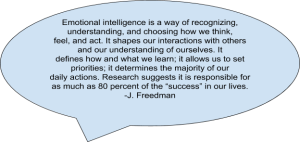5.5 Emotional Intelligence
Emotional intelligence (EI), which is also known as emotional quotient (EQ), is a topic that has been researched since the early 1990s and has been found to be an important indicator of life and career success (Maricopa Community College District, 2016). Emotional intelligence refers to a form of social intelligence that involves the ability to monitor your own as well as others’ feelings and emotions, to discriminate among them, and to use this information to guide your thinking and actions (Maricopa Community College District, 2016).

Goleman’s Theory on Emotional Intelligence
Although the term “emotional intelligence” was created by researchers Peter Salovey and John Mayer in their article “Emotional Intelligence” in 1990, true popularity of the term and the concept didn’t take place until 1995, when Dan Goleman (Image 5.7) published his first article on the topic (Karafyllis & Ulshöfer, 2008). Goleman claimed that emotional quotient (EQ) is a more important factor than intelligence quotient (IQ) in enjoying a successful life and maintaining fruitful and secure relationships with others (Karafyllis & Ulshöfer, 2008). Goleman proposed a new definition of intelligence that included qualities such as optimism, self-control, and moral character, and suggested that unlike general intelligence, which is viewed as stable over time, emotional intelligence can be learned and increased at any time during one’s life (Karafyllis & Ulshöfer, 2008).
Goleman defined emotional intelligence as “the ability to identify, assess, and control one’s own emotions, the emotions of others, and that of groups” (Karafyllis & Ulshöfer, 2008, p.135). Goleman’s four emotional intelligence competencies include self-awareness, self-management, social awareness, and relationship management.

Goleman’s Four Main Aspects to Emotional Intelligence
- Self-awareness: This refers to a person’s ability to understand their feelings from moment to moment (Maricopa Community College District, 2016). It might seem as if this is something we know, but we often go about our day without thinking or being aware of our emotions and how they impact our behaviour in work or personal situations. Understanding our emotions can help us reduce stress and make better decisions, especially when we are under pressure (Maricopa Community College District, 2016). In addition, knowing and recognizing our own strengths and weaknesses is part of self-awareness. People with strong self-awareness are realistic; they are not overly self-critical nor naively hopeful. They are honest with themselves and about themselves, as well as honest about themselves with others (Goleman et al., 2002). Self-aware people make time to reflect and think over things rather than reacting impulsively, thus bringing to their work life the thoughtful mode of self-reflection (Goleman et al., 2002). All these traits of self-awareness enable us to act with the conviction and authenticity (Goleman et al., 2002). Part of self-awareness is the idea of positive psychological capital, which can include emotions such as hope, optimism, which results in higher confidence, and resilience, or the ability to bounce back quickly from challenges. Psychological capital can be gained through self-awareness and self-management, which is our next area of emotional intelligence (Maricopa Community College District, 2016).
Self-Awareness Example
Assume that Prasad is upset about a new process being implemented in the organization. Lack of self-awareness may result in him feeling angry and anxious without really knowing why. High self-awareness EQ might cause Prasad to recognize that his anger and anxiety stem from the last time the organization changed processes and 15 people got laid off (Maricopa Community College District, 2016).
- Self-management: This refers to our ability to manage our emotions and is dependent on our self-awareness ability (Maricopa Community College District, 2016). How do we handle frustration, anger, and sadness? Are we able to control our behaviours and emotions? Self-management is also the ability to follow through with commitments and take initiative at work. Someone who lacks self-awareness may project stress on others (Maricopa Community College District, 2016). Self-management, in other words, refers to being able to manage your internal states, impulses, and resourcse (Goleman, 2015).
According to Goleman, there are six competencies related to self-management, including the following:
-
-
- Emotional self-control: Keeping disruptive emotions and impulses in check
- Transparency: Maintaining integrity
- Adaptability: Flexibility in handling change
- Achievement: Striving to improve or meet a standard of excellence
- Initiative: Readiness to act on opportunities
- Optimism: Persistence in pursuing goals despite obstacles and setbacks
-
(Goleman, 2015)
Self-Management Example
- Social awareness: This is our ability to understand social cues that may affect others around us (Maricopa Community College District, 2016). In other words, understanding how another person is feeling, even if we do not feel the same way. Social awareness also includes having empathy for another and recognizing power structures and unwritten workplace dynamics. Most people with high social awareness have charisma and make people feel good with every interaction. Daniel Goleman contends that the main component of social awareness is empathy, having the ability to perceive the feelings of others and how they see the world (Goleman, 2016). Empathy is our social radar. It requires being able to read another’s emotions; at a higher level, it entails sensing and responding to a person’s unspoken concerns or feelings. At the highest levels, “empathy is understanding the issues or concerns that lie behind another’s feelings” (Goleman, 1998, p. 4).
Social Awareness Example
Erik continually talks and does not pick up subtleties, such as body language, in meetings at the office. Because of this, he can’t understand or even fathom that his monologues can be frustrating to others. If Erik had a higher EQ in social awareness, he might still talk in meetings, but he would also spend a lot of time listening and observing to get a sense of how others feel. He might also directly ask people how they feel. This would demonstrate high social awareness (Maricopa Community College District, 2016).
- Relationship management: This refers to our ability to communicate clearly, maintain good relationships with others, work well in teams, and manage conflict (Maricopa Community College District, 2016). Relationship management relies on your ability to use the other three areas of EQ to manage relationships effectively. Relationship management is especially important when it comes to fostering diversity and inclusion in the workplace. People who are skilled in managing relationships are better equipped to handle conflict by drawing out all parties, helping others understand differing perspectives, and fostering common ideals that everyone can endorse (Goleman et al., 2002). Individuals skilled in relationship management value teamwork and encourage an atmosphere that is friendly and safe, modelling respect, helpfulness, and cooperation (Goleman et al., 2002). Relationship management has been identified as facilitating cooperation and team work, and those skilled in managing relationships take the time to identify true, authentic close relationships (Goleman et al., 2002).
Relationship Management Example
Keiko is good at reading people’s emotions and showing empathy for them, even if she doesn’t agree. As a manager, her door is always open, and she makes it clear to colleagues and staff that they are welcome to speak with her anytime (Maricopa Community College District, 2016). If Keiko has a low EQ in the area of relationship management, she might belittle people and have a difficult time being positive. She may not be what is considered a good team player, which would show her lack of ability to manage relationships (Maricopa Community College District, 2016).
Watch the video below of Dan Goleman introducing his theory of emotional intelligence. Although this is an older video, it provides a good overview of his theory and view of emotional intelligence.
(Big Think, 2012)
Improving Emotional Intelligence
To increase our self-awareness skills, we should spend time thinking about our emotions to understand why we experience a specific emotion (Maricopa Community College District, 2016). We examine those things that cause a strong reaction, such as anger, to help us understand the underlying reasons for that reaction. By doing this, we can begin to see patterns within ourselves that help explain how we behave and how we feel in certain situations. This allows us to better handle those situations when they arise (Maricopa Community College District, 2016).

To increase our self-management skills, we can focus on the positive instead of the negative (Maricopa Community College District, 2016). Taking deep breaths increases blood flow, which helps us handle difficult situations. Although seemingly childish, counting to 10 before reacting can help us manage emotions such as anger (Maricopa Community College District, 2016). This gives us time to calm down and think about how we will handle the situation. Practising positive self-talk can help increase our self-management. Self-talk refers to the thoughts we have about ourselves and situations throughout the day. Since we have over 50,000 thoughts per day (Willax, 1999), getting into the habit of managing those thoughts is important. By recognizing the negative thoughts, we can change them to be positive (Maricopa Community College District, 2016).
Table 5.1. Positive versus Negative Thoughts
| Positive | Negative |
| I made a mistake. | I am (or, that was) dumb. |
| I need to work on xx skills. | I am an idiot. |
| It may take a bit more effort to show them what I have to offer. | They will never accept me. |
| I need to reprioritize my to-do list. | I will never be able to get all of this done. |
| Let me see what seminars and training are available. | I just don’t have the knowledge required to do this job. |
(Maricopa Community College District, 2016)
Increasing social awareness means observing others’ actions and watching people to get a good sense of how they are reacting (Maricopa Community College District, 2016). We can gain social awareness skills by learning people’s names and watching their body language. Living in the moment can help our interactions with others as well. Practising listening skills and asking follow-up questions can also help improve our social awareness skills (Maricopa Community College District, 2016).
As stated above, empathy is a key component of social awareness. Frieda Edgette, a certified executive coach and organizational strategist, suggests five ways to increase your empathy and, by doing so, also increase social awareness (El-Attrash, 2020).
Five ways to increase empathy:
- Be authentic: Seek a better understanding of who you are. Develop self-awareness by exploring your identity, background, principles, and life experiences.
- Self-manage: What is your natural response when presented with difference or conflict? Do you fight, flee, or freeze up? Take note of your default response. Develop an “in the moment” strategy to practise self-control like taking a deep breath, going for a run, or just assuming a power pose.
- Practice active listening: When interacting with others, watch verbal and nonverbal cues. Make sure you turn your inner voice off for a moment and focus entirely on the other person.
- Get curious: Ask open-ended questions that start with “what” or “how.” What experiences shaped the other person’s life? Where do they get their information? What’s most important to them? Your only mission is to understand.
- Respect, connect: By being more open and more respectful of one another, we can improve communications and better connect, resulting in enhanced communication and productivity.
(El-Attrash, 2020)
Strategies for relationship management might include being open, acknowledging another’s feelings, and showing that you care (Maricopa Community College District, 2016). Being willing to listen to others and understanding them on a personal level can help enhance relationship management skills. Being willing to accept feedback and grow by using that feedback can help people be more comfortable talking with you (Maricopa Community College District, 2016). All relationships take work, time, effort, and know-how.
Approaches to relationship management that promote diverse, healthy relationships include the following:
- Continuously build trust
- Be consistent in your words and actions
- Tackle tough conversations
- Look for agreement or common ground
- Make sure people feel “heard”
- Remain open and non-defensive
- Be open and curious
- Share information about yourself
- Show genuine interest and curiosity in others
- Always work on your communication style
- Pay attention to times where your style has created confusion or troubled reactions
- Don’t avoid the inevitable
- Face reality
- Use empathy and common purpose
- Align your intention with your impact
- Think before you speak or act
- Make careful observations
(University of Florida, Human Resources, n.d.)
In this chapter, we have looked at different stages of relationships, aspects of culture that affect our relationships, self-disclosure, emotions, and emotional intelligence. These are all integral aspects of communication and are aspects of all types of relationships. In the next chapter, we will have a chance to look more closely into our relationships and how these important concepts we just discussed need to be considered when conflict occurs.
Relating Theory to Real Life
- Consider Goleman’s theory of emotional intelligence (EQ) and reflect on an experience where either yourself or another individual was lacking the EQ needed to effective handle the situation.
-
- What area of emotional intelligence needed to be developed?
- What can be done to increase emotional intelligence in this area?
- What is another way the situation could have been handled?
-
- If you could pick one of the four aspects of EQ according to Goleman to work on, which one would it be? Why? How would you work to develop this area of your EQ?
- What area of EQ do you think is the most important? Why?
Attribution
Unless otherwise indicated, material on this page has been copied and adapted from the following resource:
Granite State College. (n.d.). Cultivating your leadership capabilities. Graduate Studies, Granite State College. https://granite.pressbooks.pub/ld820, licensed under CC BY-NC-SA 4.0, except where otherwise noted.
References
Big Think. (2012, April 23). Daniel Goleman introduces emotional intelligence | Big Think [Video]. YouTube. https://www.youtube.com/watch?v=Y7m9eNoB3NU
El-Attrash, F. (2020, June 3). How to embrace diversity with empathy. https://www.govloop.com/embrace-diversity-empathy/
Goleman, D. (2018). Diversity + emotional intelligence = More success. https://www.kornferry.com/insights/this-week-in-leadership/diversity-emotional-intelligence-leadership#:~:text=Studies%20show%20teams%20innovate%20better,best%2Dselling%20author%20Daniel%20Goleman.
Goleman, D. (2016, November 21). Can you read the room? Social awareness at work. https://www.linkedin.com/pulse/can-you-read-room-social-awareness-work-daniel-goleman
Goleman, D. (2015, April 21). How emotionally intelligent are you? https://www.linkedin.com/pulse/how-emotionally-intelligent-you-daniel-goleman/
Goleman, D. (1998). Working with emotional intelligence. Bantam.
Goleman, D., Boyatzis, R. E., & McKee, A. (2002). Primal leadership: Learning to lead with emotional intelligence. Harvard Business School Press.
Karafyllis, N. C., & Ulshöfer, G. (Eds.). (2008). Sexualized brains: Scientific modeling of emotional intelligence from a cultural perspective. MIT Press.
Maricopa Community College District. (2016). Exploring relationship dynamics. Maricopa Open Digital Press. https://open.maricopa.edu/com110/, licensed under CC BY-NC-SA 4.0
Mayer, J. D., Salovey, P., & Caruso, D. R. (2000). Models of emotional intelligence. In R. J. Sternberg (Ed.), Handbook of intelligence (pp. 396–420). Cambridge University Press. https://doi.org/10.1017/CBO9780511807947.019
Salovey, J., & Mayer, J. D. (1990). Emotional intelligence. Imagination, Cognition and Personality, 9(3), 185–211. https://doi.org/10.2190/DUGG-P24E-52WK-6CDG
University of Florida, Human Resources. (n.d.). Social competency and relationship management. http://training.hr.ufl.edu/resources/LeadershipToolkit/job_aids/SocialCompetencyandRelationshipManagement.pdf
University of Minnesota. (2016). Communication in the real world: An introduction to communications studies. University of Minnesota Libraries Publishing. https://open.lib.umn.edu/communication, licensed under CC BY-NC-SA 4.0
Willax, P. (1999, December 13). Treat customers as if they are right, even when they aren’t. Louisville Business First. http://www.bizjournals.com/louisvill….html?page=all
Image Credits (images are listed in order of appearance)
Emotional intelligence by Inspiredinstruction, CC BY-SA 4.0
Daniel Goleman by anonimoa, CC BY-SA 2.0
Emotional Intelligence by Amitc008, CC BY-SA 4.0

